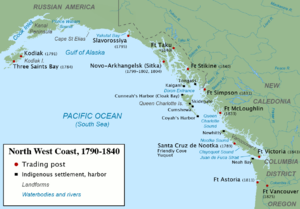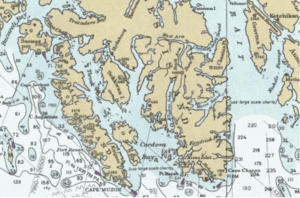Kaigani (trading site) facts for kids
Imagine a busy marketplace on the coast of Alaska, but instead of shops, it's ships and canoes! That's what Kaigani was like a long time ago, between about 1790 and 1850. It was a very important trading spot for sailors who hunted for furs and for the Kaigani Haida, who are a Native American group.
Kaigani was one of the most popular places for trading ships along the Pacific Northwest coast. Hundreds of ships, mostly from America, came here. They were mainly looking for sea otter furs. These furs were very valuable and could be sold for a lot of money in China.
Contents
Kaigani: A Historic Trading Hub
Where Was Kaigani?
The name "Kaigani" was used by traders for several safe places where ships could anchor. These spots were on the eastern side of southern Dall Island in southeast Alaska. This area is close to Cape Muzon and just north of Haida Gwaii, which is across the Dixon Entrance.
The word "Kaigani" also refers to the Haida people who lived in this region. Today, the name is still used for this general area and for different places there. For example, there's Kaigani Strait, which is between Dall Island and Long Island. There are also places called Kaigani Harbors, North Kaigani Harbor, and South Kaigani Harbor. Sometimes, the name also included nearby spots like Datzkoo Harbor and American Bay.
Why Was Kaigani Important for Trade?
During the time of the maritime fur trade, Kaigani was a very busy place. Traders, especially Americans, came to buy furs from the Haida people. The most wanted fur was from the sea otter. These furs were then taken all the way to China to be sold for high prices. This trade made Kaigani a well-known and important center on the Pacific Northwest coast.
Leaders of the Kaigani Haida
During the fur trade era, several important Haida chiefs were powerful in the Kaigani area. Some of these leaders were mentioned by the traders who visited. These chiefs played a big role in the trading activities.
Some of the chiefs included:
- Cuneah (also spelled Cunnyha, Cunnea, Cunio)
- Cow (Kow, Keow)
- Altatsee (Altadsee, Eltatsy)
- Kilchart
- Cotseye
- Lemor (Lemmato)
- Douglass (Duglos, Douglas) – His name came from a special exchange with a British trader named William Douglas.
These chiefs helped manage the trade and their communities during this busy time.
The End of an Era
After about 1840, the trading scene began to change. The Hudson's Bay Company (HBC) became the main power in the coastal fur trade. The HBC set up a trading post called Fort Simpson. This new fort quickly became more important than Kaigani as a trading site. Over time, Kaigani's role as a major trading hub slowly faded.



